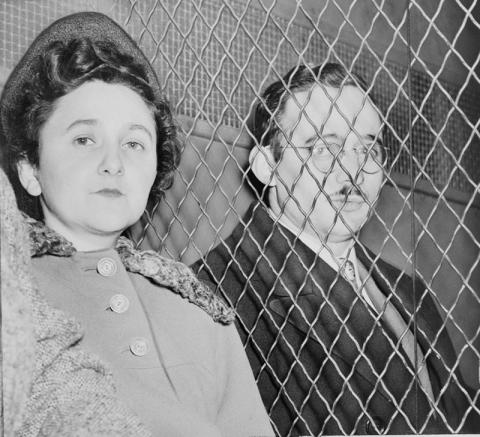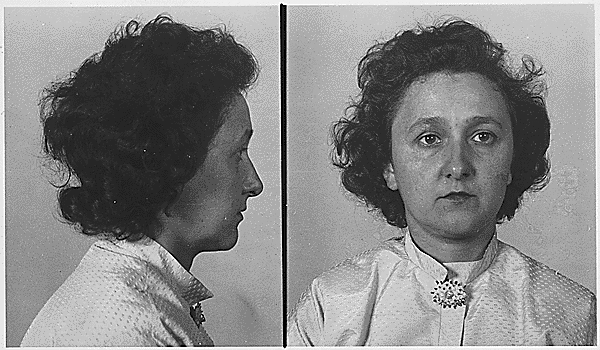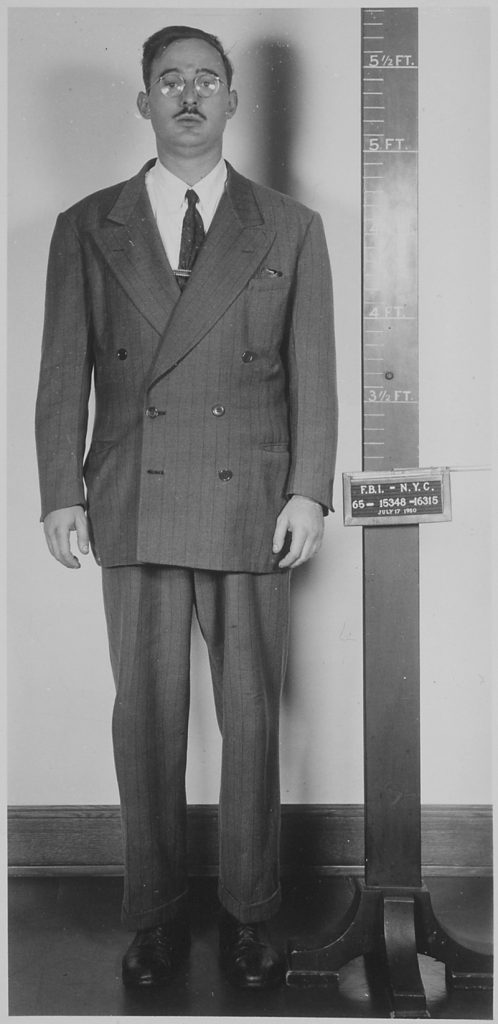 leaving court after being found guilty, 1951." width="480" height="437" />
leaving court after being found guilty, 1951." width="480" height="437" /> leaving court after being found guilty, 1951." width="480" height="437" />
leaving court after being found guilty, 1951." width="480" height="437" />
Espionage was a major concern for the United States government during the Manhattan Project. Some of the individuals who worked on the Manhattan Project were spies and provided valuable information on the design of the atomic bomb to the Soviet Union. The Soviet Union secretly conducted its first atomic weapons test on August 29, 1949. To this day, historians and scientists debate how much espionage sped up the progress of the Soviet Union’s nuclear weapons program.
Julius Rosenberg was a key Soviet spy who passed along information to the Soviet Union and recruited Manhattan Project spies. He was U.S. citizen and electrical engineer. In 1951, Julius and his wife Ethel were tried and convicted of espionage for providing the Soviet Union with classified information. They were executed in 1953. Their trial remains controversial today.
In the early 1930s, Ethel became a member of the Young Communist League. Through her activism with the Communist Party, she met Julius Rosenberg in 1936. They married in 1939. In 1940, Julius joined the U.S. Army Signal Corps as a civilian engineer. He left the Communist Party to avoid suspicions. By 1942, Julius was heavily involved with espionage activities for the Soviet Union. He provided classified documents and led an espionage network within the Manhattan Project, recruiting spies, most notably Russell McNutt and Ethel’s brother, David Greenglass, along with his wife Ruth. Ruth joined the Young Communist League (YCL) after graduating high school. She and David met in the YCL, and married in 1942.
By 1945, the Soviets considered Rosenberg and his espionage network to be providing valuable information. The network included: engineers (Julius Rosenberg, Nathan Sussman, Joel Barr, Alfred Sarant, Morton Sobell), a military aviation scientist (William Perl), a civil design engineer (McNutt), and a machinist (Greenglass), among others. Greenglass served in the Army’s Special Engineer Detachment (SED), and was a machinist at Los Alamos. McNutt was an engineer who worked at the Kellex design bureau in New York City. By 1944, Julius had recruited him to spy for the Soviets. Perl contributed to the development of the first jet fighter in the U.S. The engineers worked at top electronic firms, and they passed on confidential and useful information to the Soviet Union.
Greenglass passed information to Julius, including information about experimental molds that were used to develop the high explosive lenses. It was speculated Harry Gold, a lab chemist and Soviet spy, passed this information to the USSR. However, Walter Schneir in final verdict shows that it is much more likely that it was passed by some other method to the soviets on December 21, 1945. That same year, Julius Rosenberg had been relieved of his espionage duties because the Soviets feared he was compromised and the FBI was on to his spying activities. . Gold paid Greenglass $500 in exchange for information about the implosion lens in the atomic bomb. He also worked with Klaus Fuchs, a physicist at Los Alamos and Soviet spy, to pass on atomic research secrets.
In 1949, the U.S. Army Signal Intelligence Service (SIS) discovered that Fuchs was a Soviet spy. Decrypted cables revealed this information through the Venona project. In February 1950, Fuchs was arrested in the United Kingdom. His arrest began a chain of investigations, which ultimately led to the arrest of Julius and Ethel Rosenburg. Fuchs was charged with violating the Official Secrets Act, and he confessed to spying for the Soviet Union. That same year, the FBI arrested Gold based on information provided by Fuchs. Gold told the FBI that he stopped at a GI’s apartment in Albuquerque. Greenglass was already of the FBI’s radar because of a spy named Kaliber from the Venona decryptions. When Gold identified Greenglass, the FBI matched Kaliber to Greenglass and Liberal to Rosenburg. When questioned, Greenglass admitted to spying. He also named Julius and Ethel Rosenberg as contacts and denied that his wife, Ruth Greenglass, was involved with any espionage activities.
On July 17, 1950 the FBI arrested Julius, and one month later Ethel was arrested. On March 6, 1951 their trial began in New York’s Southern District federal court. The trial lasted for nearly one month. They were charged with conspiracy and providing atomic secrets to the USSR. They could not be charged for treason since the U.S. was not at war with the USSR. Lawyers Emanuel Bloch and Alexander Bloch defended the Rosenbergs. Sobell, who was put on trial with the Rosenberg, was defended by Edward Kuntz and Harold M. Philips.
Judge Irving R. Kaufman presided over the trial. US Attorney Irving Saypol opened the trial by stating: “The evidence will show that the loyalty and alliance of the Rosenbergs and Sobell were not to our country, but that it was to Communism. Communism in this country and Communism throughout the world. Sobell and Julius Rosenberg, classmates together in college, dedicated themselves to the cause of Communism. This love of Communism and the Soviet Union soon led them into a Soviet espionage ring.”
During the trial, both Ethel and Julius pleaded the Fifth Amendment when being questioned on being members of the Communist Party,, but did answer questions related to espionage. Not answering questions proved to be problematic for the Rosenbergs because during the era of McCarthyism, many believed that the refusal to answer questions was an admission of guilt and involvement with the Communist Party. Ethel and Julius denied all allegations of espionage, and refused to provide any names.
The FBI arrested Greenglass for espionage in June of 1950. The direct evidence of the Rosenbergs’ involvement came from the confessions and testimonies of David and Ruth Greenglass. Since the Rosenbergs were being charged with conspiracy, no tangible evidence was required.
Greenglass secretly testified before a grand jury in August 1950. In this testimony he named Julius and claimed he was recruited to join the Soviet spy ring by him. He stated that Julius asked him to help provide secrets about atomic weapons so that Julius could pass on the information to the USSR. He then claimed that he passed this information to Julius on a New York street corner, and that Ethel was not involved. He affirmed: “I said before, and say it again, honestly, this is a fact: I never spoke to my sister about this at all.”
Due to the Greenglass’ August 1950 testimony, and no tangible evidence, there was a weak case against Ethel for her alleged involvement. But this testimony was not shown to lawyers during the Rosenbergs’ trial.
Just ten days before the start of the Rosenbergs’ trial in February 1951, David Greenglass re-testified, and changed his original statements. This new testimony, now against Julius and Ethel, was part of a deal granted to the Greenglasses. In exchange for this new testimony, Ruth was permitted to remain with their children and care for them. The Greenglasses now claimed that Julius, with help from Ethel, recruited David into the atomic spy ring in 1944. At this time, Greenglass worked at Los Alamos. They claimed that David gave a sketch and description of an atomic bomb to Julius in September 1945. Now, however, Greenglass claimed that this exchange occurred in the living room of the Rosenbergs’ New York apartment, and that Ethel was present. They stated Ethel was present during all meetings, typing notes for Julius.
After David started to confess to his lawyers said “Tell the [the FBI] if they touch a hair on her [Ruth] head I’ll commit suicide and they’ll have no case.” The government told Greenglass that if he didn’t corroborate Ruth’s “new memory” that “Ethel did the typing”, his wife would be a liar. Greenglass signed a new statement agreeing with her and so that is what both Ruth and David testified to under oath. “Ruth stated in her witness testimony: “Julius then took the info into the bathroom and read it and when he came out he called Ethel and told her she had to type this info immediately. Ethel then sat down at the typewriter which she placed on a bridge table in the living room and proceeded to type the info which David had given to Julius.” The threat of indictment was threatened against Ruth as insurance against David so he would not change his testimony.
After this new testimony, the charges against Ruth were dropped. She was viewed as a co-conspirator and never indicted.
Some scholars believe that Ruth may have been the individual to type notes, due to her past involvement with the Communist Party, and conflicting statements made by David. In later interviews, he claimed: “I frankly think my wife did the typing, but I don’t remember,” and, “My wife is more important to me than my sister.” Overall, their testimony remains controversial because of the deal, the lack of tangible evidence, and the conflicting statements.
On March 29, 1951, the court convicted Julius and Ethel Rosenberg of conspiracy to commit espionage. On April 5, Judge Kaufman sentenced them to death, and sentenced Sobell to 30 years in prison. Some reports claim that the Rosenbergs were offered a plea deal, where admittance of their guilt would grant them a prison sentence. David Greenglass received a 15 year prison sentence and was released in 1960. In early 1953, he wrote a letter to President Eisenhower, requesting that Ethel and Julius’ sentences be commuted to prison. This request was denied. Judge Kaufman justified his decision for the death penalty by stating: “I consider your crimes worse than murder. I believe your conduct in putting into the hands of the Russians the A-bomb years before our best scientists predicted Russia would perfect the bomb has already caused, in my opinion, the Communist aggression in Korea, with the resultant casualties exceeding fifty thousand and who knows how many millions more of innocent people may pay the price of your treason.”

Due to Red Scare trials and newspaper headlines, Americans in the 1940s, and 1950s knew that Soviet espionage was serious. It was known that some communists, such as Fuchs, had spied for the Soviets. Despite these fears, the trial of the Rosenbergs produced mixed reactions among the public. Many Americans who were politically left-wing believed the Rosenbergs were persecuted solely for their past involvement with the Communist Party. Their legal team worked to have the verdict overturned, but their efforts failed. Neither President Truman nor President Eisenhower granted requests to remove the death sentence. The attorneys appealed to the U.S. Supreme Court nine times, but the Court never reviewed the record.

J. Edgar Hoover publicly opposed the death sentence for Ethel. He believed the execution of a young mother, would reflect negatively on both the FBI and the Justice Department. However, he did urge for prison time instead. Many commentators of the time argued that the death penalty was used unjustly in the courts as a way to force the Rosenbergs and others to confess to espionage, or to name others involved. The majority of newspapers at the time in the U.S. did, however, support the death sentence, arguing that the punishment was fair. In contrast to the American media, European newspapers did not support the ruling, and there were some protests against it throughout Europe. Despite some public outrage and failed appeals, the Rosenbergs were executed by electric chair at Sing Sing Prison on June 19, 1953. They were the only American civilians executed for espionage during the Cold War.
During the 1940s, the U. S. Army Signal Intelligence Service (SIS) conducted the Venona project. The project aimed to gather and decode messages sent by Soviet military intelligence (KGB and GRU) to the U.S. Venona would also help the government locate spy rings. The Venona project documents were still highly classified at the time of the trial and therefore could not be used as evidence.
Many of these decoded messages identified Soviet spies within the Manhattan Project. Theodore Hall is one example. He was a physicist at Los Alamos, and a valuable source to the Soviets. He escaped prosecution because his involvement was not proven until the Venona documents became unclassified. Some scholars argue that if it would have been possible to use Venona documents in court, Hall would have been revealed as a spy and prosecuted, along with Greenglass and Fuchs. The documents were not declassified until 1995.
Venona documents proved that Julius Rosenberg helped lead a productive ring of Soviet spies. Soviet cables were deciphered, revealing Julius’ codename to be “LIBERAL.” “LIBERAL” was mentioned in numerous documents. The documents suggest his involvement was with military and industrial espionage, rather than atomic espionage, as previously believed. Some scholars suggest that the chances of Ethel being executed would have been less likely had Venona documents been unclassified and used in the trial.
In 2008, the transcripts of 43 out of 46 witness testimonies before the grand jury were released, including Ruth’s testimony. These transcripts revealed the contradictions between the Greenglasses’ testimony before the grand jury and during the trial. That same year, Sobell participated in an interview with the New York Times. He stated that he and Julius passed military and industrial information to the Soviet Union, hoping it would help them defeat the Nazis in World War II. He also stated that he believed Ethel was only guilty of being Julius’ wife and was not an active participant in the espionage ring.
There are some conflicting assessments among historians regarding the outcome of the Rosenberg trial. Walter Schneir, in Final Verdict, argues that evidence against Ethel was fabricated by the Greenglasses. He also explains that Rosenberg was fired from the Army Corps of Engineers in January of 1945, and that KGB files state his espionage activities ended by 1945, so the meeting David Greenglass mentioned could never have occurred. Schneir argues that Ruth worked alone and met with a Soviet agent to deliver a sketch of a bomb, which was placed in a KGB file center on December 27, 1945. His research relies heavily on newly released KGB files.
Others argue that Julius and Ethel were guilty, with Ethel playing a minor role, but that their trial and sentence were unjust due to the lack of evidence. Harvard Law professor Alan Dershowitz stated that the Rosenbergs were “guilty and framed,” suggesting that they were spies, but that evidence was still fabricated against them, causing them to have an unjust trial and punishment.
In 2014, five historians concluded that Soviet documents show Ethel was actively involved and attended meetings with Julius and his sources, but that there is no evidence to suggest she typed specific notes. Ronald Radosh concludes, after Sobell’s 2008 confessions, that the Rosenbergs were Soviet spies. He does, however, believe that the prosecutors worked to guarantee a conviction and abused the legal system. In his viewpoint, Ethel was only minimally involved and therefore her execution was unjust.
The trial continues to be controversial today. Many individuals still question whether or not there was enough valid evidence used during the trial to convict and execute the Rosenbergs. Others question if the punishment was just for their crimes. Some atomic scientists have claimed that the information David and Julius passed along would not have been of great importance to the USSR because it was incomplete and not very detailed.
Due to the recent evidence provided by Sobell’s interview, witness testimonies, and the Venona documents, calls have been made for Ethel’s exoneration. The debate over her involvement is ongoing. Julius and Ethel’s children, Michael and Robert, maintain that their mother was innocent and have created an online petition to exonerate her. Because of the Venona documents, they now believe that Julius was a Soviet spy. They claim: “The Greenglasses’ lies were necessary to obtain Ethel’s conviction; the K.G.B. did not give her a code name, and evidently did not consider her a spy; and the prosecution’s strategy was to use Ethel to coerce her husband to confession.”